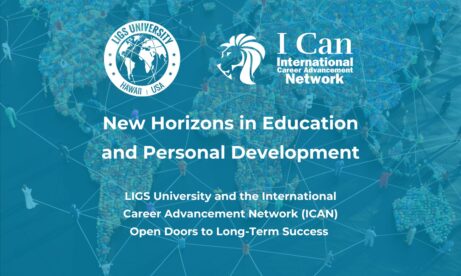
Role of human capital management on organizational efficiency in tertiary healthcare institution: a study of University of Calabar Teaching Hospital Calabar
The continuous relevance of human capital management (HCM) has attracted attention across the globe as many organizations seek to achieve professional goals in various sectors of the economy. This has made researchers and HR professionals continuously embrace HCM as the human factor that combines knowledge, skills competencies, and expertise to proffer a distinctive character to the organization (Ajisafe et al., 2015, p.9).
Human capital is an innovative and strategic contributor to organizational success linked to the ability of organizational leaders to hire the right individuals for the right positions in the organization. This has been considered a source of improving efficiency and enthusiasm in the workforce. Today, organizational efficiency is effectively influenced by emerging innovative technologies with the aid of HR analytics to manage human capital. The increasing importance of organizational personnel is therefore dependent on the ability to enhance the competitive advantage of an organization (Mishra, et al., 2019 p. 284). Increasing productivity through HR analytics as a programmer of human capital management (HCM) has been given critical attention in the 21st century (Khayinga & Muathe, 2018, p.145,). The field of HCM is effectively enabled by the innovative tool to ensure strategic goals are attained (Gibbons, 2020, p.1; Jyoti et al., 2020, p.10).
In tertiary health institutions in Nigeria, the organizational objectives are successfully accomplished through HCM. This is based on the notion that the effective management of human capital is a source of innovation and strategic change that organizations need to enhance productivity. The objective of hiring the right and competent workforce is an unpromising practice to achieve operational goals in health institutions. High competence and high performance have become the core reasons for implementing human capital for the sustainable attainment of organizational objectives. In line with these realities, the study seeks to examine the role of human capital management in organizational efficiencies in the University of Calabar Teaching Hospital Calabar
Statement of the problem
The increasing recognition of skills and competencies as tools for future success is affected by the lack of commitment of organizational leaders to deploy resources to trained manpower needed in organization. Human capital management as a strategic business activities requires knowledge and ability to execute assigned tasks, but this is affected by the inability to retain top- talented workforce to optimize productivity which results in poor return on investment to the organization and high performance culture is also undermined by the absence of relevant resources in the organization.
In tertiary health organizations, the continuous demand for top-talent individuals has imposed serious challenges on HCM as the organization becomes engaged in an impressive talent acquisition with ineffective strategic plan that affects the quality hire and retention of workers in the organization. Therefore, the capacity to ensure that employee knowledge, skills, passion, and value match the needs of the organization requires aligning the workforce to the needs of the organization. Therefore, the ineffective practices of HCM such as recruitment and selection, and employee training and development affect the acquisition of top talents into the organization due to the absence of sustainable career advancement opportunities. Based on these recognitions, this study seeks to examine the role of human capital development on organizational efficiency in the University of Calabar Teaching Hospital Calabar
Objectives of the study
The specific objectives of the study are:
- To examine the influence of recruitment and selection on strategic alignment with goals to enhance organizational efficiency in the University of Calabar Teaching Hospital Calabar
- To examine the influence of training and development on performance deficiencies to enhance organizational efficiency in the University of Calabar Teaching Hospital Calabar
Theoretical framework
This study adopted the Resource Based View Theory as the relevant theory to guide the study.
The theory emphasizes the importance of building reliable resources and aligning them to organizational success (Stiles & Kulvisaechana, 2003, p.13). RBV theory provides the organization with resources such as organizational resource, human resources, and physical resources which requires management skills, information, and knowledge to transform input into output (Hossain & Roy, 2016, p.1023). Though physical and organizational resources can be duplicated, the human capital resource is one that is inimitable which makes employees make contributions to the organization in a unique way. The contribution of human capital as an internal resource helps to maintain a competitive advantage in an organization
RBV Theory is of relevance to the study it helps an organization to know that employees are valuable resources that help to enhance efficiency when managed strategically. It allows the human resource to be acquired and developed with competencies which is not easily imitated. It enables organizations to create an environment that attracts individual with the capacity to meet the needs of the organization through continuous learning.
Conceptual framework
The conceptual framework of this study was based on the research idea or conception on human capital management. It covers the use of recruitment and selection and employee training and development in University of Calabar Teaching Hospital
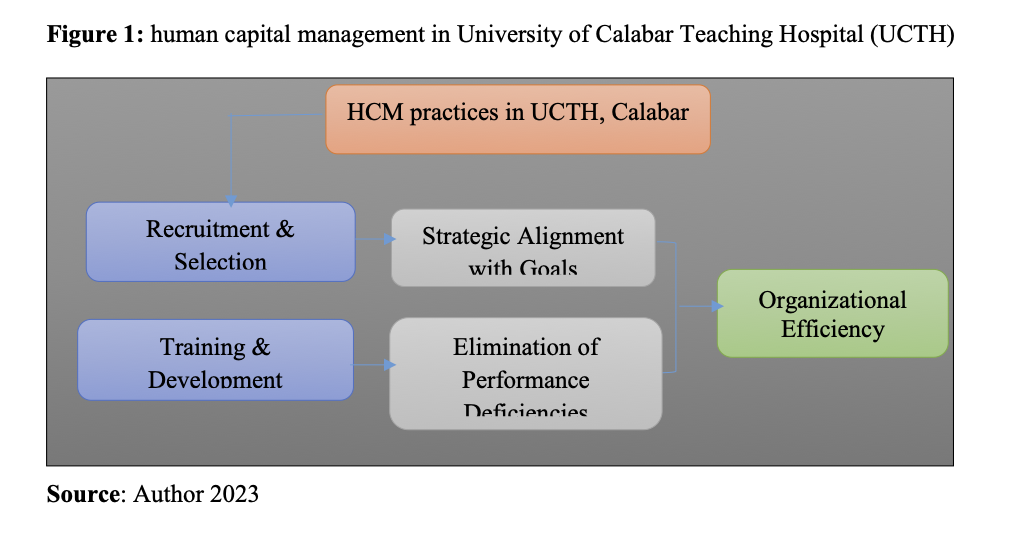
Concept of human capital management
The concept of HCM is a paradigm shift from the recognition of human resource management (HRM) which was triggered by the emergence of a knowledge-based economy and the development of a resource-based view (Kapur, 2020, p.1). These offered significant consideration to human resources to achieve competitive goals based on experience, skills, knowledge, behavuoir, education, and personality (Kapur, 2020, p.1). This indicates that the concept of HCM reinforces HRM with indispensable contributions to the management of employees in the organization. HCM is conceptualized with the ability to leverage the ideas of the employee in an effective and efficient way, aimed at achieving the bottom line goals of the organization such as market share increase, improvement in business process, augmenting profitability through improved productivity, etc (Namada, 2017, p.12). HCM is also viewed as accumulated knowledge, experience, skills, creativity, experience and other attributes that are stocked for the effective management of the organization to achieve high-level performance through human capabilities (Hossain & Roy, 2016, p.1026)
Ajisafe et al. (2015, p.15) define HCM as integrated efforts aimed at developing and managing human capabilities to align with significant performance that enhances performance goals. HCM implies people resource management for optimization and acquisition of workforce. It embodies employee training, workforce planning, recruitment, analytics, reporting, and strategy, with the aim of optimizing performance (Ajisafe et al. 2015, p16). This relates to workforce attributes such as skills, experience, and knowledge which are used to optimize productivity to achieve the strategic goals attainment in an organization (Simarmata, 2020, p.195, p.89). Ahangar (2011) conceptualizes
it as a human factor in the workplace in relation to expertise, intelligence, and skills that offer distinctive character to an organization. HCM relates to the need to maximize organizational value for optimal outcomes (Tortia et al., 2022, p.6). Hence, HCM is a method that helps to improve productivity through a comprehensive approach such as training and development, performance review, hiring, etc. Through HCM, the capability, and competence of employee helps the organization reach its full potential
Influence of recruitment and selection in organization
Recruitment and selection is an entry point for human resources into the work environment (Ahmed et al., 2016, p.52,). While recruitment helps discover and procure potential applicants for available vacancies, while selection involves screening and appointing the candidates most suitable for the job (Fernando et al., 2019, p.36). Phillipa et al. (2023, p.6)view selection as one of the prospects that the organization has in admitting candidate that is trusted to achieve the set goals of the organization. Recruitment and selection have constituted the strategic responsibilities of HCM which involves workforce planning, selection, and job analysis as enablers of organizational success. Workforce as an asset requires appropriate recruitment and selection, critical examination of jobs and timelines, and determination of the number of workforce in an organization’s timeliness (Caron & Batistic, 2019, p.20). In contemporary organizations, setting the requirements with the help of workforce planning enables effective recruitment and section practice to be implemented. Ahmed et al. (2016, p.52,) found out that the success and sustainability of an organization is the recruitment and selection which is a strong determinant of entrance into the organization. This makes HCM practice effective in improving organizational efficiency. Recruiters are able to make competence-based judgments through resource planning which helps the organization to have a high acceptance rate of the job from candidates (Ben-Gal et al., 2022). Recruitment and selection are the human capital strategies for developing effective career plans that could enhance efficiency in the organization (Ferreira et al., 2022, p.40).
Gamage, (2014, p.39,) argues that implementing a recruitment process void of a set plan constitutes low productivity and absenteeism. This indicates that with appropriate selection of workforce, and effective device that helps to pick outstanding employees that can flourish in the organization. Hence, work efficiency is driven by recruitment and selection. Raineri, (2017, p.3150) noted that in various organizations, the HCM is expressed through recruitment and selection which allows the best and outstanding employee to be attracted to an organization. This is because this function allows a pool of candidates to be available for selection and it has a significant influence on the productivity of the organization. The accomplishment of organizational goals is dependent on recruitment and selection as a staffing function of the organization (Daniel et al., 2014, p.66). This function is often driven by the scientific selection of the right candidate for the right job with adequate consideration of their competencies, educational qualifications, and aptitude for the efficient performance of the job (Abu, 2015, p.55).
A study by Kapur (2020, p.1) stresses that meaningful and effectual recruitment and selection is driven by organizational policy which could save the organization from unproductive tests or unproductive interviews as a result of the non-availability of the qualified candidate from the pool, compromise in selecting the right candidate, high rate of attrition, low productivity caused by absent of motivation in the organization. Ekwoaba et al. (2015, p.23) in their investigation support that these limitations are caused by inconsistencies or inappropriate policies and measures for effective recruitment and selection. This implies that HR policies and practices help to shape the behavior and attitude of employees. The success and efficiency of service delivery are dependent on the quality of the workforce recruited through the process of recruitment and selection A quick and expedient way of attracting applicants has brought about the advent of technology in the recruitment and selection process (Nikolaou, 2021, p.5). The adoption of e-recruitment and selection involves the use of technologies. According to Mohammed (2019, p.56), e-recruitment is a digital human resource management practice where advert for employment opportunities, corporate websites, career portals, such as job search agents, talent management systems, career websites, Candidate relationship management systems, and applicant tracking systems. Hence, an organization is able to deliver online real-time HRM solutions to the recruitment problem
Influence of training and development in organization
The concept of staff training and development is one that is interdependent complementary and very crucial to organizational effectiveness. Therefore, practice entails the act of coaching, training, mentoring, and workshops to engage workers in performing tasks and also serve as an emerging opportunity for organizational growth (Vincent, 2020, p.266). The practice of HCM influences professional development, skills training and development, etc. which makes workers valuable as their professional talent is developed to optimize productivity in an organization (Khan et al., 2011, p.65). Employee career aspiration is ascertained through training and development which is a norm that supports human resource management of an organization (Kulkarni, 2013, p.137). The need to set work objectives is an enabling factor that ensure that trainer, trainer, and evaluators are able to achieve the goals of the training which explain the expectation of the learners through a training programme
Result oriented training is imperative to achieve competitive goals in the market. To enhance efficiency, training and development is envisaged as measures for meeting the present and future gaps. Pambagio et al. (2013, p.43) note training and development as means of improving organizational functions. Also, transferred oriented training as a model has been suggested as intervention model to provide information for effective productivity. This requires identifying training environment and making it conducive to implement training and evaluating the programme. These have led to skills development in areas of interpersonal relation, decision making, and teamwork. The training and development programme requires relationship between the employer and employee which could help in preparing employee to emerging competitiveness and performance of the organization. However, a study by Olanipekun and Olanipekun (2022, p.105) suggest the important of creative behavior to support to enhance expected performance. According to Imran and Tanveer. (2015, p.23) training and development is a HRM practice positively influence efficiency in workplace. This helps to improve employee skills and competencies needed to perform assigned tasks. Different situations and organizational needs have influenced the adoption of different training methods which plays a role in improving performance. Training and development is the HR function that improve performance (Olanipekun & Olanipekun, 2022, p.107). Though the continuous advancement in technology has brought about the need training and development as measure of improving capabilities and competencies for goal attainment, Naveed (2014, p.3) add this challenge efficient training to all workers in organization is necessary. In a dynamic business environment, the achievement of competitive advantage relied on the extent of knowledge and skills acquired through training and development which aid to achieve high performance (Mozeal, 2015, p.7). This indicates employee as asset of organization is able to build the profitability and reputation of organization through relevant skills and knowledge. Karim et al. (2019, p.26) sees training as present day oriented with a focus on current job of workers, while development is the systematic and organized procedure with a long term education for managerial staff to acquire theoretical and conceptual knowledge for effective decision-making in the organization.
Specifically, employee training has been reviewed by researchers on its merits to organizational growth. For instance, a lack of competencies, skills, and knowledge constitutes a failure to accomplish set objectives (Abbas, 2014, p.96). Therefore, learning activities are adopted by many organizational leaders to ensure that employees are able to acquire the relevant skills and knowledge. Through training, the worth of the organization is balanced and workforce performance is improved. In employee development, career-enhancing skills make managers motivated as they are developed as a valuable asset that helps to enhance efficiency and effectiveness in performing assigned tasks. The development programme of the organization as a framework is used to optimize the competencies, skills, and knowledge that offer organizational leaders the ability to strategic tasks (Karim et al., 2019, p.27). A study by Vincent (2020, p.268) and Ezeani and Oladele, (2013, p.267) embraced the following methods of training and development: one, on-the-job training as a method of acquiring knowledge and skills in either a formal or informal manner. For instance, on-the-job training involves coaching a staff to acquire the relevant experience for task performance. Two, job rotation is one where a staff is rotated from one official task to the others and they are acquainted with various tasks in the organization. Three, In-house training enhances the acquisition of skills and knowledge through workshops and organized seminars aimed at ensuring the skills and knowledge of workers are updated with relevant technic for performing tasks. Fourth, In-service training is executed outside the environment of the organization. For instance, the vocational centers, and higher institutions of learning are under an agreement between the staff and the organization. Five, the work-group method is influenced by work-group discussion, and meetings which enable sound decisions for problem-solving in the organization. Six, vestibule staff training involves acquiring skills and knowledge in a same work environment with identical equipment. This method is quite indispensable for managerial functions. Seven, apprenticeship training relates to skills acquisition for a period of time. This method involves two approaches such as In the informal environment, the trainee acquires skills from the trainer within an agreed period and time. While in the formal environment, the apprenticeship is under training with payment for the course of the training (Neelam, 2014, p.87). These suggest that the importance of training and development is majorly for economic development where capacity and capability are developed to sustain organizational growth.
Factors for measuring organizational efficiency
Substantial attention has been accorded to the concept of organizational efficiency which many experts and researchers linked as a means of effective service delivery as a result of emerging technology which has affected many organizational practices (Kasim & Oyadiran 2013, p.67). Ogar & Igwe (2018, p.123) view organizational efficiency in relation to plan implementation using the least expenditure of resources. It’s tantamount to resources used in producing units of output. The use of internal and external resources constitutes factors that influence efficiency in the organization. The performance of the organization is measured by efficiency which assesses performance and promotes the accomplishment of the organizational mission, vision, goals, and objectives (Chen & Huang, 2009, p.495). Abdullah et al. (2013, p.425) view it as using specific resources to ensure that output is increased to achieve what the organization seeks to achieve. Efficiency is justified by output being delivered to accomplished goals (Abdullah et al., 2013, p.425).
However, efficiency in the organization can be identified in various ways such as through costs, resources, and time. For instance, cost efficiency is based on delivering products and services that generate the needed profit in the organization; efficiency in resources is by minimizing waste; and time efficiency is by achieving set goals within a set time (Aktas & Kryak 2011).
Organizations have various approaches for enhancing efficiency such as the use of process improvement, incentives, organizational culture education and training, and technology (Kasim & Oyadiran 2013) to enhance, p.563e the following:
One, Strategic alignment with goals helps to ensure that all elements in the organization work in relation to organizational goals (Conway, 2021, p.1). This is a state of efficiency in human capital management where the vision, mission, and business model are aligned to ensure that the recruitment and selection process is performed in a manner that is uncompromising in achieving organizational goals. Hence, strategic alignment is achieved through the implementation of the strategic plan of the organization on effect recruitment and selection of candidates for the organization. Two, performance deficiencies which is eliminated through training, and this bridges the gaps and improves performance (Zeb et al., 2017, p.5). Job training is therefore a way of eliminating deficiency in the workplace and work progress is enhanced through continuous improvement in standards. At this point, an organization is able to identify why employees are not motivated and why results are not delivered compared to the set goals. Therefore, an effective training programme is developed to eliminate performance gap and skills through identification of training need. For instance, a study by Imran and Tanveer. (2015, p.25) focused on training with capacity to remove deficiencies and bridge gaps
In addition, two ways of measuring organization efficiency could be through workforce efficiency and management (Rodriguez & Walter, 2017, p.210). For instance, workforce efficiency shows the extent to which employees are being committed to the organizational priorities and goals. This indicates that employees must have clear roles and responsibilities, and the implementation of the strategic programme of the organization must aimed at improving employee skills and knowledge. This is aimed at enhancing the potential and efficiency of employees to deliver the expected objective of the organization. While in management efficiency, the efficiency level is inevitable as employees are trained in addressing diversity in the workplace. This requires coordinating the efforts of workers seeking means to improve operations and ensuring that redundant and inefficient processes are removed (Rodriguez & Walter, 2017, p.212). Hence, the above measures of organizational efficiency are means of achieving set goals where goods and services are proffered to meet the demand of customers. This affirms the views of Kasim and Oyadiran (2013, p.68) that the collective contributions of workers influenced the achievement of organizational objectives as tasks are executed in an efficient manner
Methodology
This survey covered the management staff of the University of Calabar Teaching Hospital on the role of human capital management on organizational efficiency with a sampled population of 297 staff. Data were elicited from the structured questionnaire and were self-administered to the respondents. The researcher recovered 280 copies of the questionnaire from 297 copies distributed which indicates a response rate of 94 percent. A five-point Likert scale question was designed to support the data collection. The study adopted five-point Likert scale descriptive statistics and hypotheses were tested with the use of SPSS version 23 on Exploratory Factor Analysis (Principal component Analysis) and Multiple Regression analysis. In addition, the Cronbach Alpha Coefficient of 0.7 was used to ascertain the reliability of the test instrument as shown below:

Result and analysis
Factor analysis on human resource management
The principal component analysis (PCA) technique was adopted to validate the construct contained in the research instrument. With the use of PCA, the constructs that were designed to measure human capital management were extracted to cover two components namely: the Eigenvalues greater than 1 and Varimax with the Kaiser Normalization rotation method. The Communalities were extracted for each construct which indicated an acceptable value that is greater than 0.5. Each of the extracted values showed a factor loading that was greater than 0.5 as shown in Table 2 below. This affirms the Rule of Thumb stresses that an average loading must be greater than 0.5 for each construct (Hair et al, 2010, p.19). The Kaiser-Meyer-Olkin Measure of Sampling Adequacy (KMO) showed that the value is greater than 0.5 which indicated the adequacy of the sampling and normality was without a problem. Sequel to this, Bartlett’s Test of Sphericity is significant (.000) which indicates the suitability of the variables for structure detection. Also, the matrices for component correlation were greater than the 0.3 threshold, which Hair et al. (2010, p.19) recommended to be acceptable. Therefore, these constructs have a valid measure of human capital management.
In line with the PCA result, recruitment and selection as a component consisted of (trusted selection of candidates, workforce planning, competent-based judgment, and strategic goals); while training and development consisted of (elimination of deficiencies, employee career aspiration, result-oriented training, and continuous advancement in technology, and competitive advantage). These contributed to the independent variable of the study
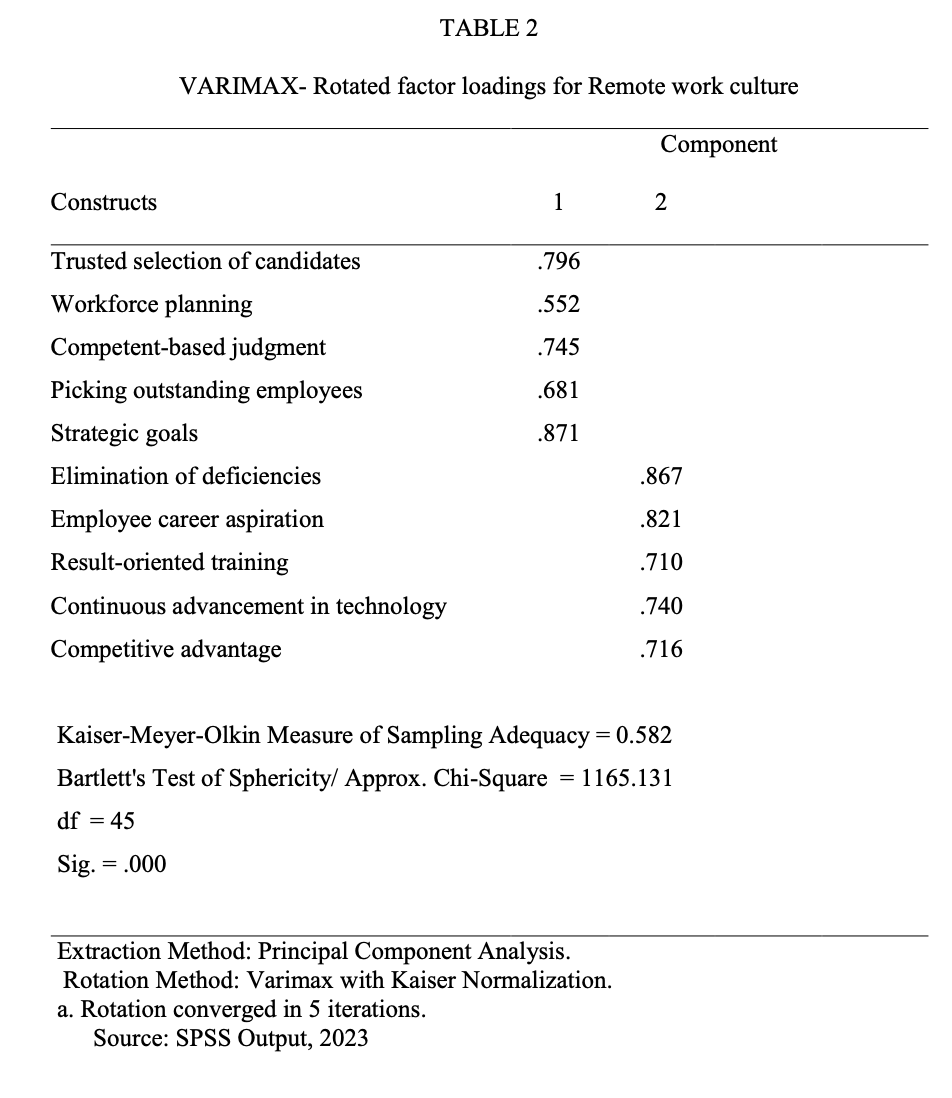
Factor analysis on organizational efficiency
The constructs that were designed to measure organizational efficiency were extracted using the method for Eigenvalues greater than 1 and Varimax with Kaiser Normalization rotation. The Communalities for all the constructs had an acceptable value level greater than 0.5 as indicated in Table 3 below. This affirms the Rule of Thumb which stresses that each construct should have an average loading that is greater than 0.5 as recommended by Hair et al. (2010, p.21). The Kaiser-Meyer-Olkin Measure of Sampling Adequacy (KMO) in the Table below is greater than 0.5 which indicates the adequacy of the sampling and the normality has no problem. Therefore, Bartlett’s Test of Sphericity of (.000) is significant which indicates the suitability of the variable for structure detection. Also, the correlation matrix component with a threshold of 0.3 is greater, and it is acceptable (Hair et al, 2010, p.22). This implies organizational efficiency is validly measured by the constructs.
In line with the PCA result, organizational efficiency as a component consisted of (remote training, paradigm shift, set out roles and responsibilities, mentor-learner engagement, and time management). These contributed to the dependent variable of the study

Demographic characteristics of respondents
Table 4 shows the respondents’ demographic. Data obtained from the survey indicates that 159 respondents representing 56.8 percent were male while 121 respondents representing 43.2 were female. Data obtained from the survey on age range reveals that 76 representing 27.1 percent were 21 and 25 years; 146 respondents representing 51.1 percent were 26 and 30 years; 40 respondents representing 14.3 percent were 31 and 40 years; and 17 respondents representing 6.5 percent were between 41 years and above. This is an indication that mature respondents participated in the survey. On educational qualification, data obtained from the survey revealed that 83 respondents representing 29.6 percent had ND/NCE; 106 respondents representing 37.9 percent had B.Sc./HND; 54 respondents representing 19.3 percent had MBA/M.Sc./MA qualification; 37 respondents representing 13.2 percent had Ph.D. qualification holders. On working experience, data obtained from the survey revealed that 122 respondents representing 43.6 percent worked between 1 to 9 years; 69 respondents representing 26.6 percent worked between 10 to 20 years; while 89 respondents representing 31.7 percent had working experience of 21 years above in the organization. On marital status, data obtained from the survey revealed that 94 respondents representing 33.6 percent were single; 142 respondents representing 50.7 percent were married; while 44 respondents representing 15.9 percent were divorced as at the time of obtaining the data. Lastly, on staff cadre, the data obtained reveals that 138 respondents representing 49.3 percent were senior staff; 75 respondents representing 26.8 percent were supervisors; and 23 respondents representing 23.9 percent were junior staff as at the time of obtaining the data.
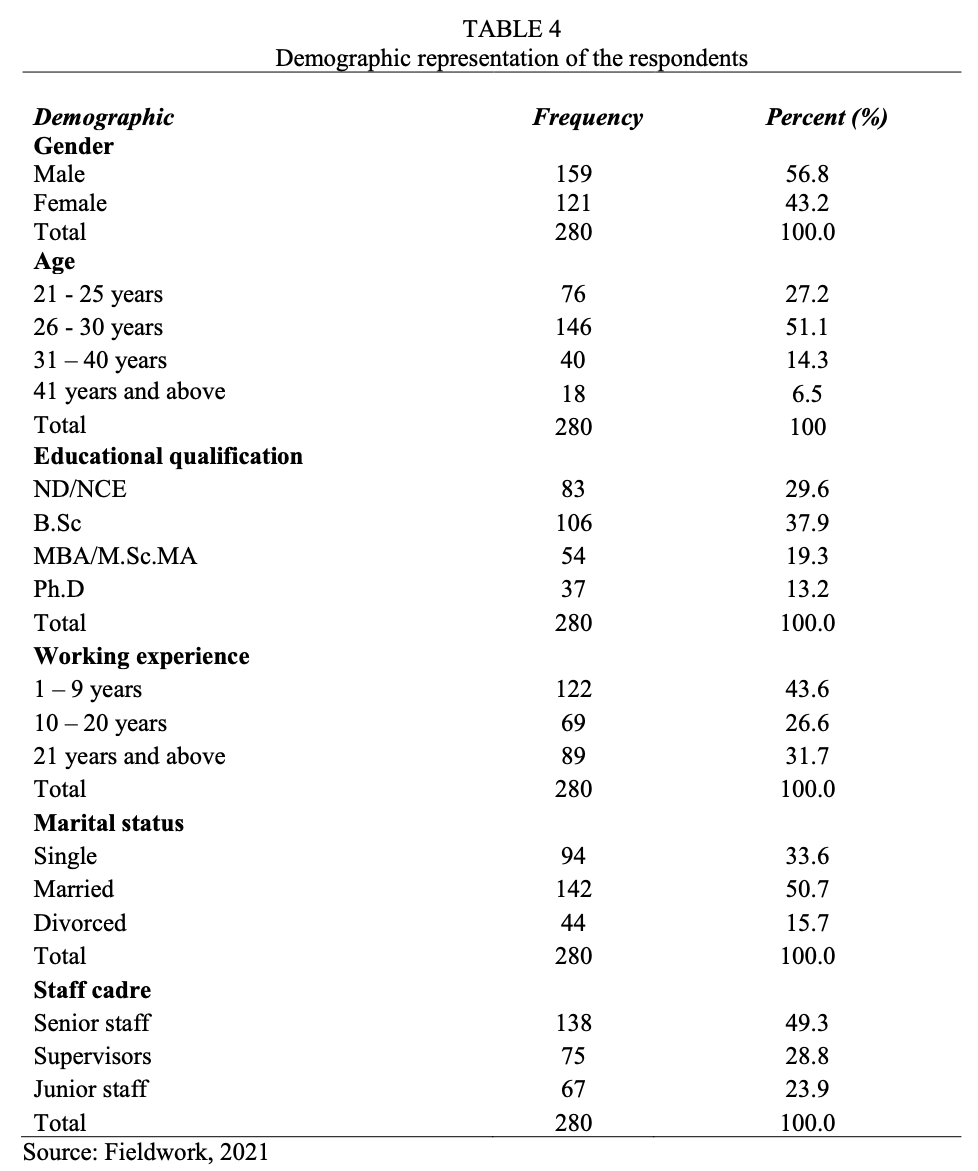
Descriptive statistics of variables
The descriptive statistics in Table 5 show responses on human capital management and organizational efficiency in the studied organization. Data from 280 respondents were covered in this report and human capital management was measured by recruitment and selection, and training and development. The constructs designed to measure recruitment and selection had a mean of 2.5 and above which affirms a positive response to the research questions. A 68 percent spread of the value was affirmed to cluster around the mean with a standard deviation below 1. This confirmed adequacy in the spread of data
The constructs designed to measure training and development had a mean of 2.5 and above which affirms a positive response to the research questions. A 68 percent spread of the value was affirmed to cluster around the mean with a standard deviation below 1. This confirmed adequacy in the spread of data
Organizational efficiency in the studied organization was measured by; accomplishment of the organizational mission, the use of process improvement, and minimization of waste, employees committed to the organizational priorities, and improved operations in the organization. The constructs designed to measure organizational efficiency had a mean of 2.5 and above which affirms a positive response to the research questions.
The standard deviation for the first and third constructs Shows a 68 percent spread of the value was affirmed to cluster around the mean with a standard deviation below 1. This confirmed adequacy in the spread of data. On the other hand, the second construct shows a standard deviation above 95 percent confirmed adequacy in the spread of data
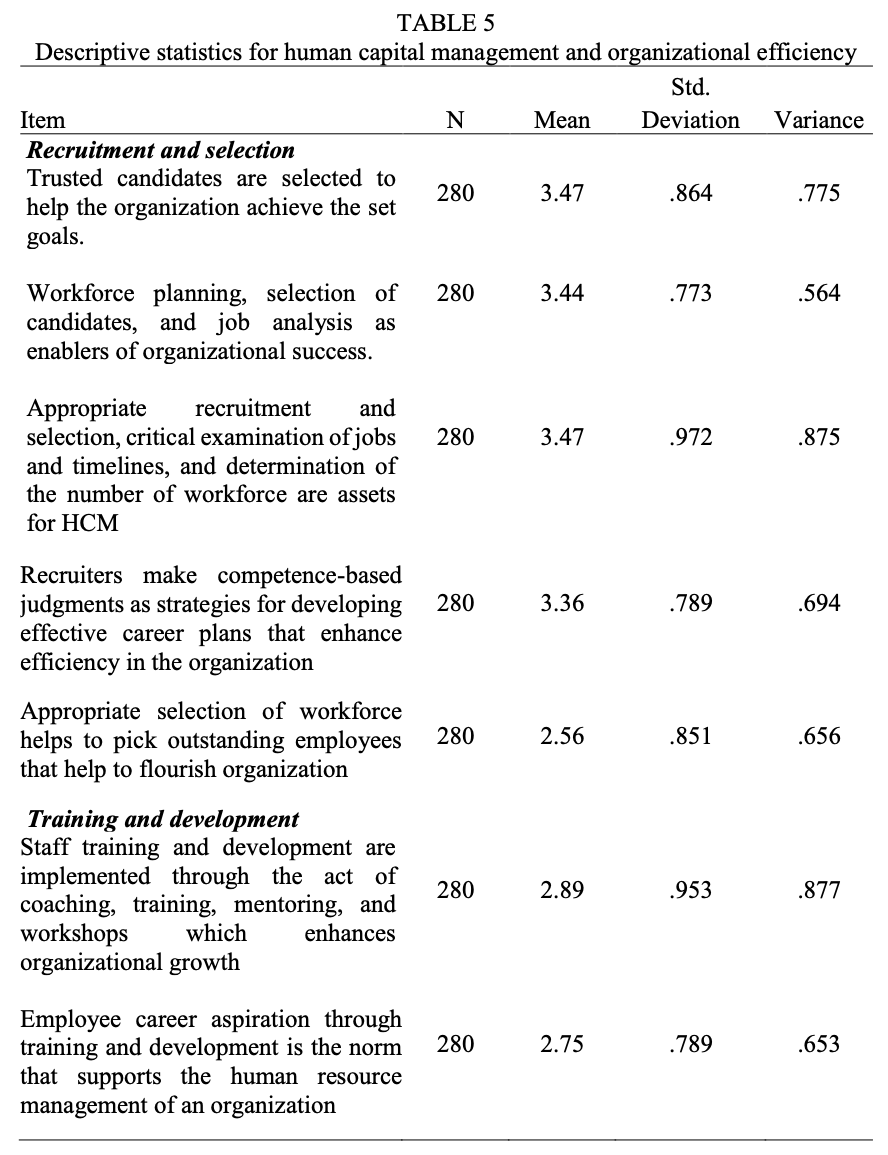


Homoscedasticity test
The use of Homoscedasticity helps to show the equivalent level of exhibition of dependent variables across the predictor variables. Also, the Ordinary Least Square (OLS) Regression analysis was of the assumption different samples are drawn equally from the population variance. Therefore, this study carried out Levene’s test of equality to determine the homoscedastic of the variable, and the result affirmed a satisfactory condition of the variables for homoscedasticity which implies equality of variance for independent variables of the study.
Multicollinearity test
The multicollinearity test was conducted with the use of tolerance value and Variance Inflation Factor (VIF) to ascertain the existence of high intercorrelations with the predictor variables. The tolerance entails the percentage of variance which cannot explain the other predictors, and where the tolerances are closer to zero, it implies high multicollinearity, and the regression coefficient is inflated by the standard error. In relation to the rule of thumb, the tolerance should not be lower than 0.1 and VTF should not exceed 5 as recommended by Ringle, Wande & Becker (2015). Therefore, the result in Table 7 below shows that multicollinearity had no issues as the tolerance values were above 0.1 and Variance Inflation Factors were on the threshold of less than 5.
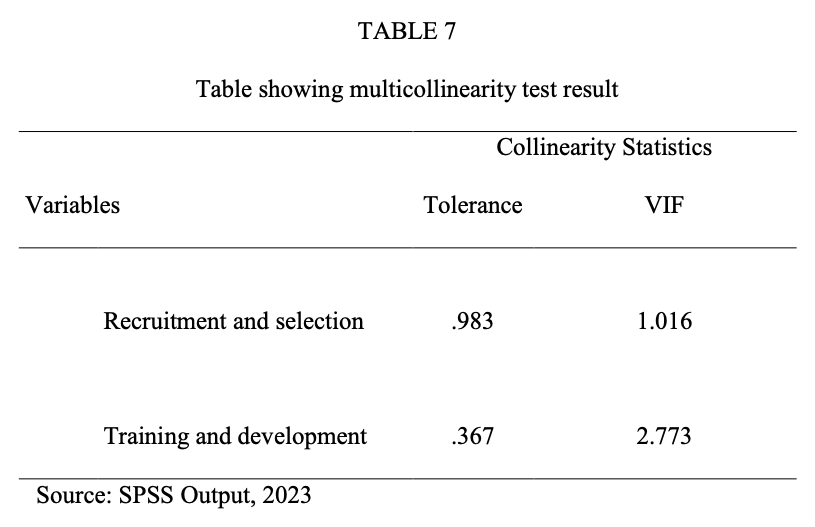
Test of hypotheses
Hypothesis one:
H01: Recruitment and selection do not significantly influence strategic alignment with goals to enhance organizational efficiency in the University of Calabar Teaching Hospital Calabar
Hypothesis two:
H02: Training and development do not significantly influence performance deficiencies to enhance organizational efficiency in the University of Calabar Teaching Hospital Calabar
A multiple linear regression analysis was used to determine the role of human capital management on organizational efficiency at the University of Calabar Teaching Hospital, Calabar. Tables 8, 9, and 10 showed the result of multiple regression on organizational efficiency. An R-value of .446, R-square of .194, and adjusted R-square of .187 were estimates that revealed the goodness of fit of the data to the model. The adjusted R-square value (.187) implies that the independent variables (recruitment and selection, and training and development) accounted for 18.7 percent of the organizational efficiency in the studied organization. 81.3 percent of organizational efficiency was not accounted for by the variables. Therefore, the two variables: recruitment and selection, and training and development influence organizational efficiency as seen from their p value which is less than 0.05. The regression result demands that the null hypotheses be rejected and the alternative. Hence, the recruitment and selection significantly influence strategic alignment with goals to enhance organizational efficiency; and training and development significantly influence performance deficiencies to enhance organizational efficiency in the University of Calabar Teaching Hospital Calabar
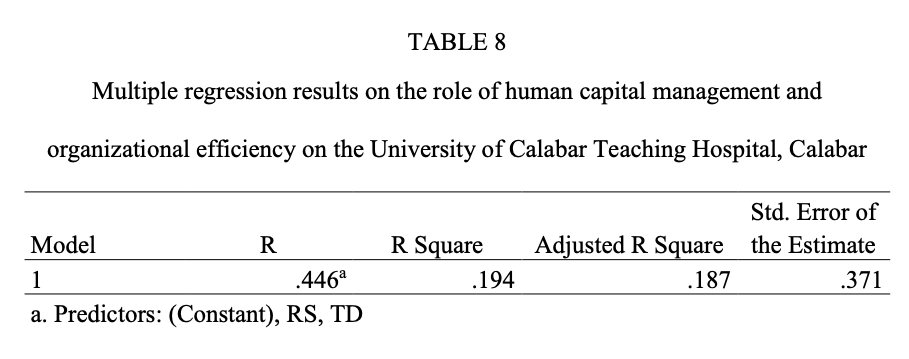
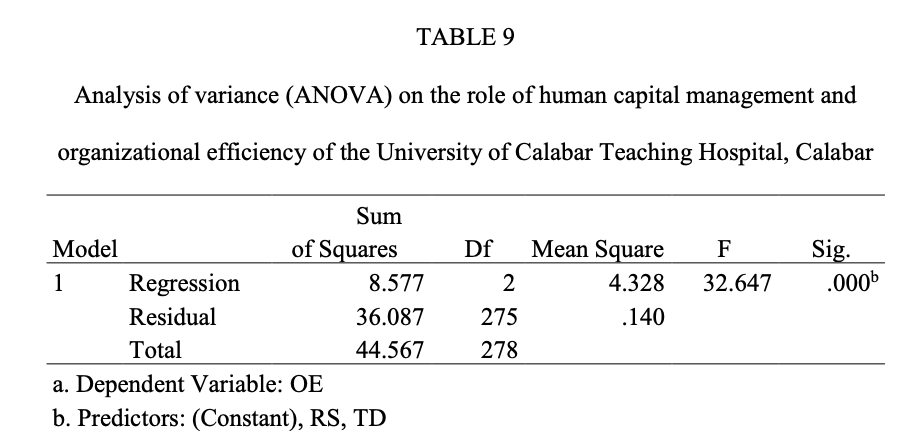

Findings
The regression result on the first hypothesis reveals that recruitment and selection significantly influence strategic alignment with goals to enhance organizational efficiency in the University of Calabar Teaching Hospital Calabar (Beta = 0.286, P<0.05). In line with the findings Caron and Batistic (2019, p.13) stressed that in contemporary organizations, setting the requirements with the help of workforce planning enables effective recruitment and section practice to be implemented. This is a fact because the success and sustainability of an organization is the recruitment and selection which is a strong determinant of entrance into the organization. 232 respondents representing 82.8 percent were of agreement that workforce planning, selection of candidates, and job analysis as enablers of organizational success. In the studied organization, recruiters make competence-based judgments as strategies for developing effective career plans that enhance efficiency in the organization; appropriate selection of workforce helps to pick outstanding employees that help to flourish organization; recruitment and selection determine the number of workforce as assets for human resource management. The performance goals have helped to assess the organizational efficiency in generating the needed profit, minimizing wastage, and achieving the set goals of the organization
The regression result on the second hypothesis revealed that training and development significantly influence performance deficiencies to enhance organizational efficiency in the University of Calabar Teaching Hospital Calabar (Beta = 0.343, P<0.05). This aligned with the views of Vincent (2020, p.268) that the practice of human capital management influences professional development, skills training and development, etc. which makes workers valuable as their professional talent is developed to optimize productivity in an organization. This is true because by setting work objectives trainers are able to achieve the goals of the training. In the studied organization. Responses from 229 respondents representing 81.7 percent affirmed that staff training and development are implemented through the act of coaching, training, mentoring, and workshops which enhances organizational growth. Therefore, in the studied organization the practice of employee training and development enhances the career aspiration of workers; result-oriented training enhances organizational functions; and continuous advancement in technology has influenced training and development for improved capabilities and competencies for goal attainment. Therefore, workforce efficiency has made employees committed to the organizational priorities and goals, and the efforts of workers are coordinated to improve operations in the organization
Conclusion and Recommendations
The organizational priority for strategic alignment and improving performance deficiency are enabled through human capital management practice. This study reviewed the influence of recruitment and selection, and training and development on organizational efficiency. It is inevitable that the role of human capital management has made employees committed to the goals of the organization. Efficiency in management helps to address workforce diversity, and the efforts of employees are coordinated to improve the performance of the organization. Based on these, the following recommendations were adduced:
- The continuous practice of recruitment and selection should be a culture that aligns with hiring and retaining satisfied employees to optimize the operational and health goals of the organization. This would require sourcing talented and trusted employees to enhance the operational and health goals of the organization.
- The organizational policy for training and development should be reviewed based on future abilities to retain top talents to shape the effectiveness and performance of the organization. This requires continuous investment in career development to provide the needed skills, knowledge, and competencies to achieve operational organizational goals
Bibliography:
Abbas, Z. (2014). Identification of factors and their impact on employees’ training and organizational performance in Pakistan. Kasbit Journal of Management and Social Science, 7(1): 93-109.
Abu, Z. M. H. (2015). Recruitment and selection process of a private commercial bank in Bangladesh. American Journal of Service Science and Management, 2(5), 54-58.
Abdullah, L & Laafar, S. & Taib, L. (2013). Human capital indicator. Journal of Applied Sciences, 13(3), 423-429
Ahangar, R. G. (2011). The relationship between intellectual capital and financial performance: an empirical investigation in an Iranian company’, African Journal of Business Management, 5(1). 88-95.
Ahmed, S., Ahmad, F. & Joarder, M. H. R. (2016). HRM practices-engagement-performance relationships: A conceptual framework for RMG sector in developing economy shaheen. Mediterranean Journal of Social Sciences, 7(4), 150–157
Ajisafe, O. E., Orifa, R. A. O. & Balogun, J. A. (2015). Influence of human capital management on organizational performance. Journal of Resources Development and Management, 14, 8-14
Aktas, E. & Kryak, M. (2011). The effect of organizational culture on organizational efficiency: The moderating roles of environment and CEO values. Procedia-Social and Behavioural Sciences, 24, 560-1573
Bekele, A. Z., Shigutu, A. D. & Tensay, A. T. (2014). The effect of employees’ perception of performance appraisal on their work outcomes International Journal of Management and Commercial Innovation, 2, 136-173
Ben-Gal, H. C., Forma, I. A., & Singer, G. (2022). A flexible employee recruitment and compensation model: A bi-level optimization approach. Computers and Industrial Engineering, 165(5), 1233-1241
Caron, E., & Batistic S. (2019). Knowledge hubs in competence analytics: With a case study in recruitment and selection. Proceedings of the 14th International Conference on Software Technologies.
Chen, C. J. & Huang, J. W. (2009). Strategic business resource practice innovation performance: Mediating role of knowledge management capacity. Journal of Business Research, 62(1), 493-511
Conway, B. (2021). Strategic alignment: HR and company business goals working as one. https://www.employeeconnect.com/blog/strategic-alignment-hr-and-company-business-
Daniel, A., Sanda, A. A. Midala, A. S. (2014). Recruitment, selection and placement of human resource in adult education organization: Implications for the management of adult education Borno State Nigeria. Journal of Education and Practice, 5(31), 64-72
Ekwoaba, J. O., Ikeije, U. U. & Ufoma, N. (2015). The impact of recruitment and selection criteria on organizational performance. Global Journal of Human Resource Management, 3(2), 22-33
Ezeani, N. E. & Oladele, R. (2013). Implications of training and development programmes on accountant’s productivity in selected business organizations in Onitsha, Anambra State, Nigeria. International Journal of Asian Social Science, 3(1), 266-281
Gamage, A. S. (2014) Recruitment and selection practices in manufacturing smes in japan: An analysis of the link with business performance Ruhuna Journal of Management and Finance, 1, 37–52
Gibbons, M. (2022). What is human capital management (HCM)? https://peoplemanagingpeople.com/articles/human-capital-management/
Fernando, W. H. M., Yusoff, S. K. M. Khatibi, A. & Ferdous, A. S. M. (2019). A review on human capital: Two principal ideas predominantly generic human capital and specific human capital for organizational performance.European Journal of Economic and Financial Research, 3(5), 35-47
Ferreira, C., Robertson, J. & Pitt, L. (2022). Business (un)usual: Critical skills for the next normal. Thunderbird International Business Review, 12(3), 39-46
Jyoti, J., Sharma, P., & Rani, A. (2020a). Assessing the impact of human resource management practices on teachers’ performance through HR analytics. New York: Palgrave Macmillan.
Kapur, R. (2020). Importance of recruitment and selection in leading to progression of organization.https://www.researchgate.net/publication/339123280_
Karim, M. M., Choudhury, M. M. & Latif, W. B. (2019). The impact of training and development on employees’ performance: an analysis of quantitative data. Noble International Journal of Business and Management Research, 3(2), 25-33
Kasim, U. & Oyadiran, P. (2013). Improving organizational efficiency through quality service delivery strategies. International Journal of Social Sciences and Humanities Review, 4(3), 66-74
Khan, R. A. G., Khan, F. A., & Khan, M. A. (2011). Impact of training and development on organizational performance. Global Journal of Management and Business Research, 11(7), 63–69.
Khayinga, C. M., & Muathe, S. (2018). Human capital development and organizational performance: Review and critique of literature and a research agenda. International Journal for Innovation Education and Research, 6(2), 144–153.
Kulkarni, P. (2013). A literature review on training and development and quality of work life. International Refereed Research Journal, 4(2), 136–143.
Hair, J. F., Black Jr. W. C., Babin, B. J. & Anderson, R. E. (2014). Multivariate Data Analysis. 7th ed. Harlow, England: Pearson Education Limited.
Hossain, M. U. & Roy, I. (2016). Human capital management: the new competitive approach. International Journal of Commerce, Economic and Management, 4(5), 1020-1035
Imran, M. & Tanveer, A. (2015) Impact of training and development on employees performance in banks of Pakistan. European Journal of Training Development Studies, 3 22-44
Mishra, D., Luo, Z. & Hazen, B. T. (2018). The role of informational and human resource capabilities for enabling diffusion of big data and predictive analytics and ensuing performance. Contributions to Management Science, 12(8), 283–302.
Mozael, B. M. (2015). Impact of training and development programs on employee performance. International Journal of Scientific and Research Publications, 5(11), 38-42.
Mohammed, S. (2019). The introduction and use of electronic recruitment on the recruitment process in organizations: benefits of this technology for recruiting organizations. Global Journal of Human Resource Management, 7(5), 45-59
Namada, J. M. (2017). Organizational learning and firm performance: An empirical investigation in an Emerging Economy Context. International Journal of Business Social Sciences Studies and Research, 1(1) 10-18
Naveed, A. N. I. (2014). Impact of training and development on the employee performance: A case study from different banking sectors of North Punjab. Arabian Journal of Business and Management Review, 2(4), 1-5
Neelam, T. (2014). The impact of training and development on employee’s performance and productivity: A case study of United Bank Limited Peshawar city, KPK, Pakistan. International Journal of Academic Research in Business and Social Sciences, 4(4), 86-98
Nikolaou, J. (2021). What is the role of technology in recruitment and selection? The Spanish Journal of Psychology, 24(2), 1–6
Ogar, C. A. & Igwe, M. N. (2018). Effect of human capital management on organizational efficiency: A study of Zenith Bank Plc Calabar, Cross Rive State, Nigeria. International Journal of Research and Innovation in Social Science, 2(5), 122-133
Olanipekun, L. O. & Olanipekun, D. O. (2022). Effect of training and development programs on perceived employees job performance in selected insurance companies in Lagos State. Periodica Journal of Modern Philosophy, Social Sciences and Humanities, 3, 102-118
Pambagio N S, Utami & Gunawan, E (2013). Influence of process recruitment, selection process and competence of employee on employee performance (studies on the employees division of administration and finance. Journal. of Business Administration, 6, 41–47
Phillipa, O. Ishaq, M. & Kola, A. A. (2023). Effects of recruitment and selection process on performance in organizations. International Journal of Human Resource Management and Humanities, 1(1), 1-26
Raineri, A. (2017). Linking human resources practices with performance: the simultaneous mediation of collective affective commitment and human capital. International Journal of Human Resource Management, 28(22), 3149–3178.
Ringle, C. M., Wande, S. & Becker, J. (2015). SMARTPLS 3. Bonningstedt: SmartPLS. Retrieved from http://www.smartpls.com
Rodriguez, J. & Walter, K. (2017). The importance of training and development in employee performance and evaluation. World-wide Journal of Multidisciplinary Research and Development, 3(10), 206-212
Simarmata, J. (2020). The practices of HRM, human capital, and organizational performance: A literature discussion in SME context. Jurnal Manajemen dan Sains, 5(2), 192-199
Stiles, P., & Kulvisaechana, S. (2003). Human capital and performance: A literature review. Judge Institute of Management, University of Cambridge December, 1-39
Tortia, E. C., Gago, M. Degavre, F. & Poledrini, S. (2022). Worker involvement and performance in Italian Social Enterprises: The role of motivations, gender and workload. Sustainability, 14(2), 1–20
Vincent, M. (2020). Impact of training and development on employee job performance in Nigeria. Saudi Journal of Humanities and Social Sciences, 5(5), 265-268
Zeb, A., Abdullah, N. H. Javaid, M. & khan, M. A. (2017). Impact of human capital management practices on employees’ job performance. International Post Graduate Conference on Applied Science and Physics, 1-11
Author: Welle Lawrence, student LIGS University
Co-author: Simon Peter Koffi
Approved by: Catherine Muthu, lecturer LIGS University



